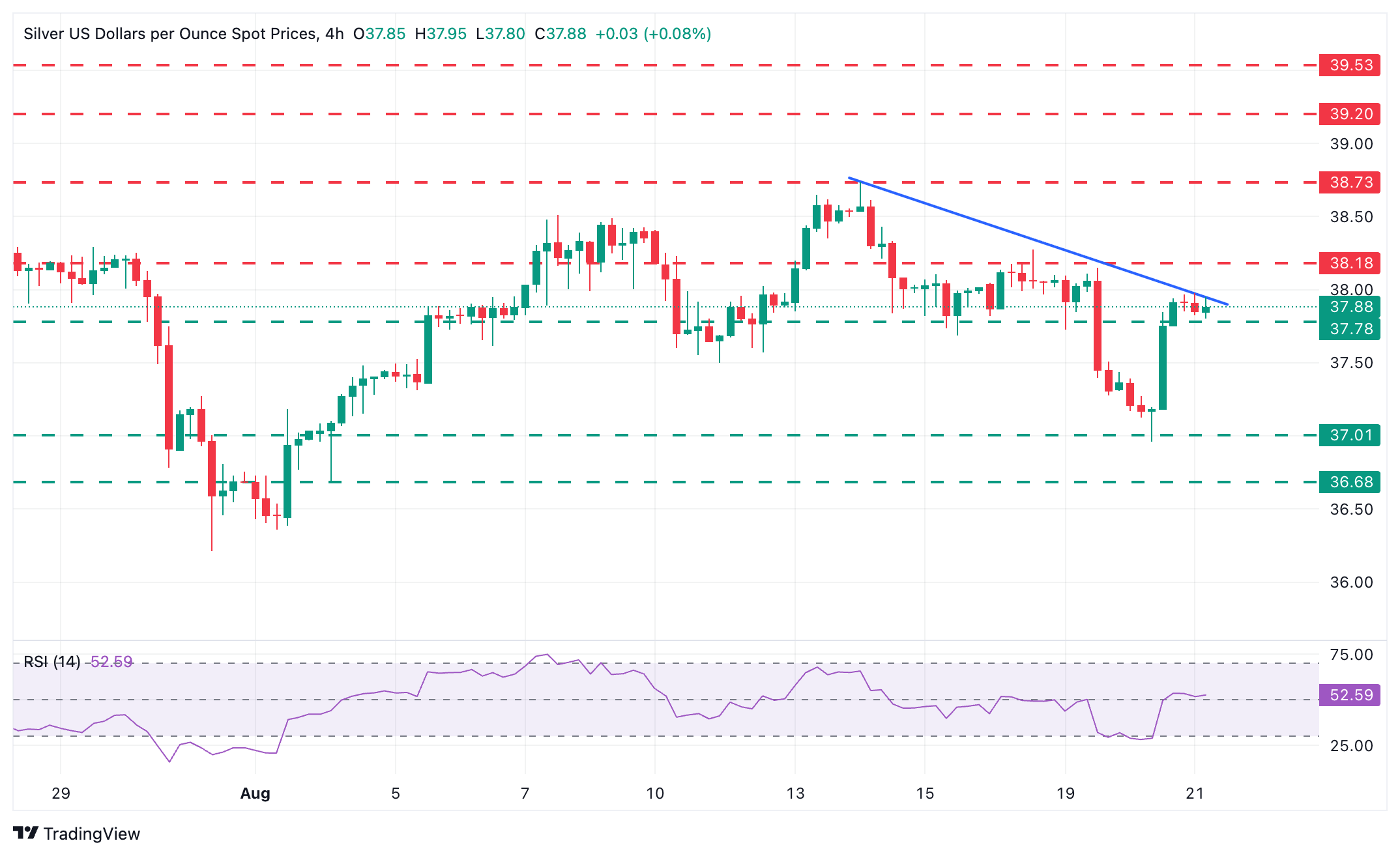Silver Price Forecast: XAG/USD recovery stalls at $38.00 as the US Dollar firms up
- Silver recovery from two-week lows has been halted at $38.00.
- A moderate US Dollar pickup is weighing on precious metals on Thursday.
- XAG/USD remains capped below trendline resistance, with the broader negative trend intact.
Silver (XAG/USD) is posting moderate losses on Thursday, after having rallied about 1.35% on Wednesday. Bulls are struggling to find acceptance above the $38.00 level, with the US Dollar firming up ahead of the all-important Fed Powell speech at the annual Jackson Hole meeting.
The pair drew some support from the renewed political pressure on the Federal Reserve, as US President Donald Trump called for the resignation of Governor Cook over an alleged mortgage fraud. Cook’s refusal “to be bullied” and investors' fears that the Fed Chief might cool market hopes of a September cut on Friday keep the US Dollar bid on Thursday.
Technical analysis: XAG/USD is testing trendline resistance at $38.00

The precious metal found support in the area between the 61.8% and 78.6% Fibonacci retracement levels of the early August rally, a common target area for corrective reversals, and bounced higher on Wednesday. The pair, however, remains capped below descending trendline resistance from the August 14 highs, which leaves the broader bearish trend intact
Bulls need to break above the mentioned trendline, now around the $38.00 level and extend gains above the $38.15-$38.25 area (August 19 and 18 highs, respectively), to confirm that the corrective phase is completed, and the path towards the mentioned August 14 high, at $38.73, would be clear.
To the downside, a bearish reversal below the intra-day low of $37.80 would bring Wednesday’s low of $37.00 back to the focus. Further down, the next downside target is the August 4 low, at $36.65.
Silver FAQs
Silver is a precious metal highly traded among investors. It has been historically used as a store of value and a medium of exchange. Although less popular than Gold, traders may turn to Silver to diversify their investment portfolio, for its intrinsic value or as a potential hedge during high-inflation periods. Investors can buy physical Silver, in coins or in bars, or trade it through vehicles such as Exchange Traded Funds, which track its price on international markets.
Silver prices can move due to a wide range of factors. Geopolitical instability or fears of a deep recession can make Silver price escalate due to its safe-haven status, although to a lesser extent than Gold's. As a yieldless asset, Silver tends to rise with lower interest rates. Its moves also depend on how the US Dollar (USD) behaves as the asset is priced in dollars (XAG/USD). A strong Dollar tends to keep the price of Silver at bay, whereas a weaker Dollar is likely to propel prices up. Other factors such as investment demand, mining supply – Silver is much more abundant than Gold – and recycling rates can also affect prices.
Silver is widely used in industry, particularly in sectors such as electronics or solar energy, as it has one of the highest electric conductivity of all metals – more than Copper and Gold. A surge in demand can increase prices, while a decline tends to lower them. Dynamics in the US, Chinese and Indian economies can also contribute to price swings: for the US and particularly China, their big industrial sectors use Silver in various processes; in India, consumers’ demand for the precious metal for jewellery also plays a key role in setting prices.
Silver prices tend to follow Gold's moves. When Gold prices rise, Silver typically follows suit, as their status as safe-haven assets is similar. The Gold/Silver ratio, which shows the number of ounces of Silver needed to equal the value of one ounce of Gold, may help to determine the relative valuation between both metals. Some investors may consider a high ratio as an indicator that Silver is undervalued, or Gold is overvalued. On the contrary, a low ratio might suggest that Gold is undervalued relative to Silver.

